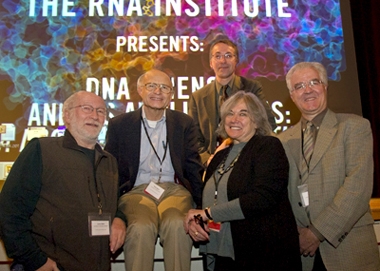Nine Distinguished Scientists, including Nobel Laureate Ada Yonath, Will Serve as the Scientific Advisory Board for UAlbany's RNA Institute
ALBANY, N.Y. (November 3, 2011) – UAlbany's RNA Institute announced today that nine distinguished scientists, including Nobel Laureate Ada Yonath and members of the prestigious National Academy of Sciences and Howard Hughes Medical Institute, will serve as its Scientific Advisory Board.
The board's formation was announced by Paul F. Agris, founding director of The RNA Institute, at its global symposium held at UAlbany. More than 200 scientists, researchers and industry thought leaders from around the world, including several advisory board members, are participating in the symposium, which is focusing on progress and potential in the field, particularly for diagnosis and treatment of diseases.
 |
|
RNA Institute Director Paul Agris, second from left, is joined by four members of the new Scientific Advisory Board for the Institute. From left, the members are: Larry Gold, Ronald Breaker, Marlene Belfort and Eric Westhof. (Photo by Mark Schmidt) |
"The formation of this advisory board is an important step in the development of The RNA Institute. Every member of the board was chosen because of distinguished contributions to RNA science through research and entrepreneurship. The Scientific Advisory Board, selected by the Institute’s Faculty Advisory Board, will provide strategic guidance to The RNA Institute as it grows. We are honored they have agreed to serve," said Agris.
The Scientific Advisory Board members include:
- Ada Yonath, Nobel Laureate and Member, National Academy of Sciences. Recognized as the pioneer of ribosome crystallography, Yonath, a member of the National Academy of Sciences, was awarded the Nobel Prize in Chemistry in 2009 for her studies on the structure and function of the ribosome along with Venkatraman Ramakrishnan and Thomas Steitz.
- Marlene Belfort, Member, National Academy of Sciences, and Distinguished Professor at the University at Albany. Belfort's research interests run the gamut from answering fundamental questions about gene function and integrity to evolution of genetic control and its exploitation in biotechnology.
- Ronald Breaker, Investigator, Howard Hughes Medical Institute; Chair and Henry Ford II Professor, Department of Molecular, Cellular and Developmental Biology, and Professor, Molecular Biophysics and Biochemistry, Yale University. Breaker conducts research on RNA as a molecular switch that controls how and when genes are turned on or off. He co-founded two biotechnology companies, Archemix in Cambridge, Massachusetts and BioRelix in New Haven, Connecticut, developing antibiotics that target bacterial RNA switches.
- Thomas R. Gingeras, Professor and Head of Functional Genomics, Cold Spring Harbor Laboratory. Gingeras is a member of an international consortium that has spent four years studying the way genes are organized in the chromosomes.
- Larry Gold, Member, National Academy of Sciences; Professor, Molecular, Cellular and Developmental Biology, University of Colorado at Boulder; CEO, Somalogic, Inc. Gold invented a universally utilized RNA technology, SELEX, with Craig Tuerk. SELEX is a selection process to find unique RNAs that bind to specific proteins that cause disease. This pioneering invention led to Macugen, an approved drug for the treatment of macular degeneration.
- Rachel Green, Investigator, Howard Hughes Medical Institute; Associate Professor, Department of Molecular Biology & Genetics, The Johns Hopkins University School of Medicine. Green studies the mechanism and extraordinarily high fidelity of protein production in cells and its regulation.
- Christine Guthrie, Member, National Academy of Sciences; Professor, Biochemistry and Biophysics, University of California, San Francisco. Guthrie has made key contributions to the processes needed by a cell to produce RNA that is capable of normal function. Scientists now estimate that 50 percent of inherited diseases result from missteps in these processes that Guthrie is studying and that insights could lead to new diagnostics and more sophisticated therapies.
- Dieter Söll, Member, National Academy of Sciences; Sterling Professor of Molecular Biophysics and Biochemistry, Professor of Chemistry, Yale University. The editor of nine books and author of over 460 scientific articles, Söll is responsible for showing how the genetic blueprint of three letter codes in DNA represent the 20 common amino acid components of proteins. He spearheaded international efforts to adopt a common computer database and format for recording masses of genetic information gleaned in the worldwide initiative to decipher the entire human genome.
- Eric Westhof, Vice President for Research and Doctoral Studies, University of Strasbourg; Director, CNRS Institute of Molecular and Cellular Biology and CNRS Unit Architecture and Reactivity of RNA; Professor, Structural Biochemistry, University of Louis Pasteur of Strasbourg; Member, French Academy of Sciences, Academy of Europe. Westhof's research activities have resulted in an understanding of how the large RNA molecule folds into three dimensions in order for it to function properly. He has spearheaded the systematic identification and nomenclature for these structures.
The RNA Institute at the University at Albany was launched in June 2010. It brings together leading researchers from higher education and other institutions, and offers advanced facilities for early phase RNA-based drug discovery.
![]() For more news, subscribe to UAlbany's RSS headline feeds
For more news, subscribe to UAlbany's RSS headline feeds
A comprehensive public research university, the University at Albany-SUNY offers more than 120 undergraduate majors and minors and 125 master's, doctoral and graduate certificate programs. UAlbany is a leader among all New York State colleges and universities in such diverse fields as atmospheric and environmental sciences, business, education, public health,health sciences, criminal justice, emergency preparedness, engineering and applied sciences, informatics, public administration, social welfare and sociology, taught by an extensive roster of faculty experts. It also offers expanded academic and research opportunities for students through an affiliation with Albany Law School. With a curriculum enhanced by 600 study-abroad opportunities, UAlbany launches great careers.


